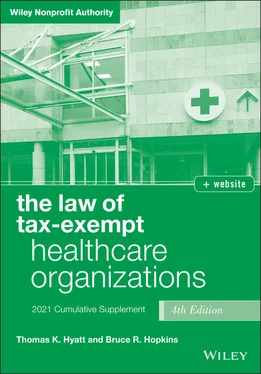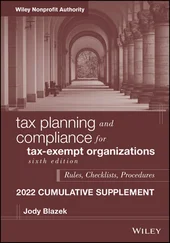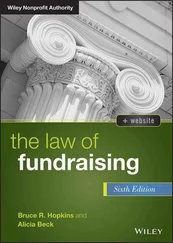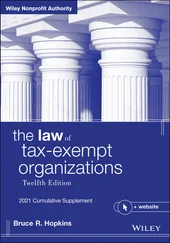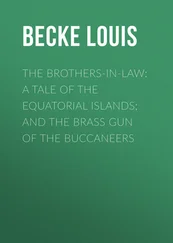Bruce R. Hopkins - The Law of Tax-Exempt Healthcare Organizations
Здесь есть возможность читать онлайн «Bruce R. Hopkins - The Law of Tax-Exempt Healthcare Organizations» — ознакомительный отрывок электронной книги совершенно бесплатно, а после прочтения отрывка купить полную версию. В некоторых случаях можно слушать аудио, скачать через торрент в формате fb2 и присутствует краткое содержание. Жанр: unrecognised, на английском языке. Описание произведения, (предисловие) а так же отзывы посетителей доступны на портале библиотеки ЛибКат.
- Название:The Law of Tax-Exempt Healthcare Organizations
- Автор:
- Жанр:
- Год:неизвестен
- ISBN:нет данных
- Рейтинг книги:4 / 5. Голосов: 1
-
Избранное:Добавить в избранное
- Отзывы:
-
Ваша оценка:
- 80
- 1
- 2
- 3
- 4
- 5
The Law of Tax-Exempt Healthcare Organizations: краткое содержание, описание и аннотация
Предлагаем к чтению аннотацию, описание, краткое содержание или предисловие (зависит от того, что написал сам автор книги «The Law of Tax-Exempt Healthcare Organizations»). Если вы не нашли необходимую информацию о книге — напишите в комментариях, мы постараемся отыскать её.
The Law of Tax-Exempt Healthcare Organizations — читать онлайн ознакомительный отрывок
Ниже представлен текст книги, разбитый по страницам. Система сохранения места последней прочитанной страницы, позволяет с удобством читать онлайн бесплатно книгу «The Law of Tax-Exempt Healthcare Organizations», без необходимости каждый раз заново искать на чём Вы остановились. Поставьте закладку, и сможете в любой момент перейти на страницу, на которой закончили чтение.
Интервал:
Закладка:
The ruling is issued against a backdrop of continuing incremental changes in the operation of nonprofit health maintenance organizations and their increasing resemblance to traditional commercial insurance providers. Also in the mix is the ongoing uncertainty regarding the meaning of a 1986 change in federal law (designed largely to bar continued tax exemption for Blue Cross and Blue Shield plans) that denies tax exemption for substantial providers of commercial‐type insurance, and its application to HMOs.
The primary weapon for the report's conclusion is the court's holding in the Vision Service Plan case to revoke tax exemption as a social welfare organization for an eye‐care service provider due to its substantial member focus and its operation like a for‐profit business. The report readvocates at great length the IRS's winning arguments in the Vision Service Plan case and seeks to extend its reach in a manner that would effectively eliminate tax exemption for HMOs, even for those that significantly serve Medicaid patients. For good measure, the report invokes an oft‐asserted IRS and common law theory—the commerciality doctrine 150 —to condemn as ineligible for exemption any nonprofit HMO that undertakes those common business methods that are necessary to effectively operate and remain viable in the provision of managed healthcare. This is all curious since it comes at a time when Congress has recently embraced 151 the ability of certain types of nonprofit health insurance issuers to qualify for tax‐exempt status and when managed care plans play an important role in extending coverage to uninsured individuals under the Affordable Care Act.
For now, the ruling continues the long‐standing IRS position in favor of recognizing arranger‐type nonprofit HMOs as tax‐exempt social welfare organizations. But the arguments contained in the report on examination are likely to resurface and bear careful monitoring both with the IRS and in the courts.
Also, in a final adverse ruling that was not appealed, the IRS determined that an HMO did not qualify for exemption as a social welfare organization. 152 The organization was a new nonprofit corporation that acquired the assets and assumed the business of a for‐profit HMO by merging with it. As a result of the merger, it became affiliated with a group of healthcare entities, including a medical school, a faculty practice plan, an accountable care organization, and a hospital. The organization continued the business of its for‐profit predecessor, including offering healthcare plans through a health insurance exchange under the Affordable Care Act. It was an arranger and administrator of healthcare services through its plans, providing prepaid healthcare services primarily to its subscribers. It also undertook social welfare activities, including providing financial assistance to individuals and families who were unable to afford the plan premiums, making grants for health research and capital improvement projects, hosting mammography screening events, and providing access to clinically based education materials. It also shared health information with a data warehousing initiative formed by its affiliate.
The IRS concluded that the organization was not operated primarily for the promotion of social welfare, since the overwhelming majority of its activities related to providing healthcare plans to its paying subscribers. The number of its subscribers who were low‐income and qualified for subsidies was minor in relation to its subscriber populations as a whole. In addition, its social welfare activities represented a minor component of its overall activities. The IRS stated that to qualify for tax exemption as a social welfare organization, an organization's activities must primarily benefit the community rather than its own members.
The IRS also determined that the organization did not qualify for tax exemption as an integral part of its affiliated medical school. Even though the medical school controlled its operations, and its administrative functions were intermingled with it, the HMO did not provide any necessary or indispensable services exclusively to the medical school. In addition, the organization continued to arrange for healthcare services to be delivered by providers and facilities outside of its health system, and thereby failed to qualify as an integral part of the medical school.
In another ruling, the IRS considered an application for recognition of tax exemption as a charitable organization from an entity formed for the purpose of providing health insurance for every resident of a state for a fee and opening an affordable healthcare facility, also for a fee. The IRS denied recognition of exemption, concluding that the organization was not operated exclusively for charitable purposes, but rather was providing commercial‐type insurance and medical services on a fee‐for‐service basis. In addition, the IRS determined that the organization's provision of commercial‐type insurance was substantial, thereby disqualifying it for recognition of exemption as a charitable organization under the Code. 1 53
The IRS easily concluded that the entity was providing commercial‐type insurance because its articles of incorporation and its description of activities indicated that its purpose was to provide healthcare insurance for a fee. The entity did not meet any of the exceptions to commercial‐type insurance described in the Code and it did not provide insurance substantially below cost or limit the insurance to a class of charitable recipients. With regard to the question of substantiality, the IRS noted that the entity planned to devote 100 percent of its efforts toward establishing and marketing its insurance program in its first year of operations, and would spend 50 percent of its total activities on its insurance program in the second through fourth years of operation. Even after it was established, the entity planned to spend 30 percent of its total activities on its insurance program. Based on applicable case law, the IRS concluded that these amounts are substantial. Furthermore, 94 percent of the entity's revenue was slated to come from insurance sales and 94 percent of its expenses were planned for payments for the healthcare expenses of its insureds. Accordingly, the provision of commercial‐type insurance was deemed substantial, which precluded the entity from securing exemption as a charitable organization.
NOTES
1 145.1 EO Update, October 13, 2017.
2 145.2 “Audit Technique Guide—Other 501(c)(3) Organizations,” https://www.irs.gov/pub/irs-tege/atg_hmo.pdf.
3 149 Priv. Ltr. Rul. 201538027.
4 150 See § 24.24.
5 151 See IRC § 501(c)(29).
6 152 Priv. Ltr. Rul. 201451033.
7 153 Priv. Ltr. Rul. 202015035.
Конец ознакомительного фрагмента.
Текст предоставлен ООО «ЛитРес».
Прочитайте эту книгу целиком, купив полную легальную версию на ЛитРес.
Безопасно оплатить книгу можно банковской картой Visa, MasterCard, Maestro, со счета мобильного телефона, с платежного терминала, в салоне МТС или Связной, через PayPal, WebMoney, Яндекс.Деньги, QIWI Кошелек, бонусными картами или другим удобным Вам способом.
Интервал:
Закладка:
Похожие книги на «The Law of Tax-Exempt Healthcare Organizations»
Представляем Вашему вниманию похожие книги на «The Law of Tax-Exempt Healthcare Organizations» списком для выбора. Мы отобрали схожую по названию и смыслу литературу в надежде предоставить читателям больше вариантов отыскать новые, интересные, ещё непрочитанные произведения.
Обсуждение, отзывы о книге «The Law of Tax-Exempt Healthcare Organizations» и просто собственные мнения читателей. Оставьте ваши комментарии, напишите, что Вы думаете о произведении, его смысле или главных героях. Укажите что конкретно понравилось, а что нет, и почему Вы так считаете.
